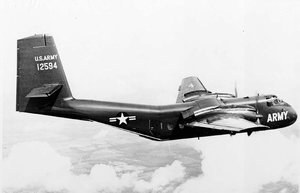De Havilland Canada DHC-4 Caribou
|
|
| C-7 Caribou | ||
|---|---|---|
 | ||
| Description | ||
| Role | STOL utility transport | |
| Crew | 3 | |
| Dimensions | ||
| Length | 72.58 ft | 22.12 m |
| Wingspan | 95.58 ft | 29.13 m |
| Height | 31.66 ft | 9.65 m |
| Wing area | 912 ft² | 84.7 m² |
| Weights | ||
| Empty | 18,260 lb (B variant) | 8,283 kg |
| Loaded | 31,000 lb | 14,198 kg |
| Powerplant | ||
| Engines | Two Pratt and Whitney R-2000-7M2 Twin Wasp 14-cylinder | |
| Power | 1,450 hp | 1081 kW |
| Performance | ||
| Maximum speed | 216 mph | 348 km/h |
| Combat range | 1,307 mi | 2,103 km |
| Ferry range | 242 mi | 389 km |
| Service ceiling | 24,800 ft (B) | 7,559 m |
| Rate of climb | 1,355 ft/min | 413 m/min |
The de Havilland Canada DHC-4 Caribou (known in the US military as the C-7 Caribou) was designed as a specialized transport for STOL (short takeoff and landing). It was first flown in 1958 and delivery was taken by the United States Army in 1961. In Army hands, the craft was known as the CV-2 Caribou.
The Army purchased 159 of the aircraft and they served their purpose as a tactical transport well during the Vietnam War, where larger cargo aircraft such as the C-123 Provider and the C-130 Hercules could not land on the shorter landing strips. The aircraft could carry 32 troops or two Jeeps or similar light verhicles. The rear loading ramp could also be used for parachute dropping.
In 1967, a political decision was made by the United States Air Force who demanded that the Army turn them over as fixed-wing aircraft was the job of the Air Force. In exchange, however, the Army traded the Caribou to the Air Force in exchange for an end to the restrictions on helicopters in the Army.
Most of the C-7s have since been phased out of the military.
The Royal Australian Air Force still operates 14 caribous.
External link
- GlobalSecurity.org: C-7 / CV-2 Caribou (http://www.globalsecurity.org/military/systems/aircraft/c-7.htm)
| Related content | |
|---|---|
| Related Development | |
| Similar Aircraft | |
| Designation Series | |
| Related Lists | |
|
Lists of Aircraft | Aircraft manufacturers | Aircraft engines | Aircraft engine manufacturers Airports | Airlines | Air forces | Aircraft weapons | Missiles | Timeline of aviation |
